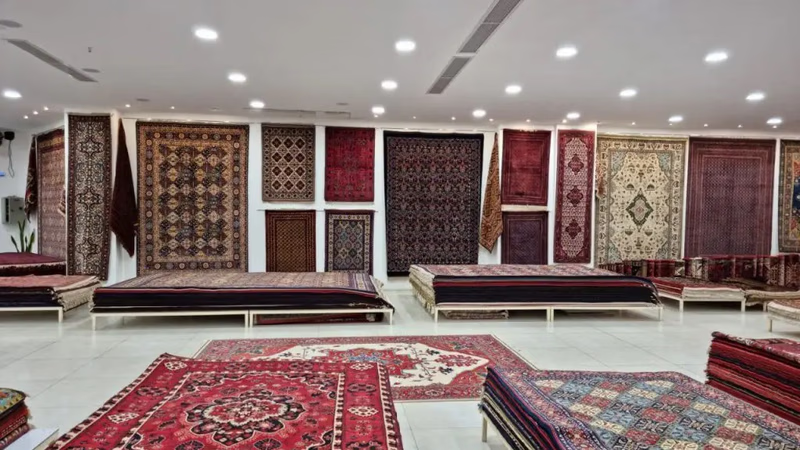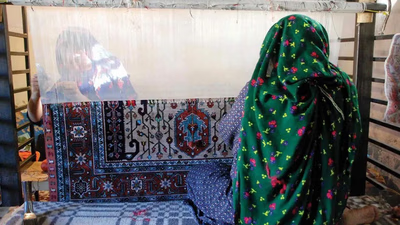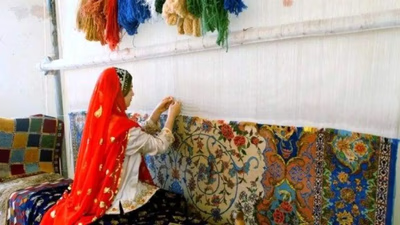
Explore the unique features of carpets and rugs.
Carpets and rugs are both types of carpets, but there are differences in their preparation, design, and use. A carpet is a type of carpet made from cotton, wool, silk or industrial threads. Galim is also a type of traditional carpet made from wool or cotton threads. The design and texture of the carpet depends on the respective region and culture. Carpets usually have a compact texture and high density and are used in homes and indoor environments. Rugs usually have a dry and relatively open texture and are suitable for use in outdoor spaces such as sidewalks, mountains, and deserts.
The designs and colors of carpets can be very diverse and are often designed in floral designs, geometric shapes or natural designs such as trees and animals. The design and colors of rugs are usually simpler and more geometric than carpets, and they use simple geometric designs such as lines and triangles. The main difference between carpet and rug is in their texture, density, use and designs. Carpets are mostly used indoors and as decorative pieces, while rugs are used outdoors and as traditional carpets.
Woolen and cotton threads are the two main raw materials for weaving rugs. But in addition to wool and cotton, the fibers used in carpets include other options such as silk and fluff, and of course, these options have increased in the texture of car carpets and synthetic fibers are also added to them. Both rugs and carpets have unique characteristics in terms of arts and crafts . Both rugs and carpets are considered handicrafts. This means that their production requires manual and artistic skills.
Both rugs and carpets are recognized as works of art due to their unique designs and motifs. The designs of rugs and carpets usually consist of symbols, shapes, animals, flowers and geometric patterns and are related to local history, culture and taste. Both rugs and carpets are made from natural resources such as wool, cotton and silk threads. These natural resources show handicraft works how to live and the environment of their production place.
Rugs and carpets are considered as part of the cultural heritage of a region or country. These works of art and handicrafts represent the history, art and culture of the people that have been passed down from generation to generation and have a high cultural and historical value. As works of art and handicrafts, rugs and carpets have significant marketing value. These works are usually used as decorative pieces inside homes, hotels and cultural complexes. Also, they are popular as souvenirs and gifts.
Both rugs and carpets have a special value in terms of arts and crafts, which are in accordance with the history, culture and art of the people, according to the latest accessible information, rugs and carpets have many characteristics in terms of arts and crafts. A carpet consists of different parts and materials. Wool is one of the most important raw materials used in making carpets. Wool can be made from sheep, goats or other animals. Carpet woven wool is mainly soft, long-lasting and durable.
In some carpets, industrial threads such as polypropylene threads are used. These threads are made artificially and some have different characteristics than wool. Different colors are used to dye the carpet. Colors can be natural or artificial. In the traditional methods of preparing carpets, natural colors such as colors extracted from plants, sunflowers and insects are used. While in industrial methods, artificial colors are used.
The pattern of the carpet is also an important part of its structure. These designs and motifs are created manually or using weaving machines on the carpet and give it beauty and variety. The combination of these parts and different materials causes the formation of the carpet structure. The texture of the carpet is usually compact and has a high density, and these different materials are combined and woven by hand by artisans. The process of preparing rugs and carpets includes weaving, coloring and designing, which is done manually by artisans and craftsmen.
-

The value of Middle Eastern handwoven carpets in international trade is influenced by various factors, including quality, design, size, materials, and production location. These carpets are often seen as cultural symbols, which can enhance their market value. Notably, Iranian carpets are highly regarded for their intricate designs and craftsmanship, while Turkish carpets are celebrated for their unique patterns and high-quality materials. Arabic carpets from the Persian Gulf region are recognized for their traditional designs and vibrant colors. Afghan carpets also hold significant value due to their diverse designs and high-quality wool. The price range for these carpets can vary widely, with some fetching millions of dollars as they are considered works of art. Economic conditions, demand and supply dynamics, cultural significance, and market trends all play crucial roles in determining the value of these rugs in global markets. Accurate valuation requires ongoing analysis of these factors to adapt to changing market conditions.
-

Carpets and rugs, while both classified as carpets, differ significantly in their preparation, design, and intended use. Carpets are typically made from materials such as cotton, wool, silk, or synthetic fibers and are characterized by a compact texture and high density. They are primarily used indoors for decorative purposes. In contrast, rugs have a more open texture and are often utilized in outdoor settings. The designs of carpets tend to be intricate and diverse, featuring floral patterns or geometric shapes that reflect regional cultures. Rugs usually exhibit simpler geometric designs. Both carpets and rugs are considered handicrafts that require artistic skills for their production. They embody cultural heritage through their unique motifs and materials sourced from local environments.
The marketing value of these items is significant; they serve as decorative pieces in homes and hotels or as souvenirs. Wool is a primary raw material for both carpets and rugs, with variations in the use of industrial threads for added durability. The dyeing process can involve natural or artificial colors depending on the method used. Overall, the craftsmanship involved in creating carpets and rugs highlights their importance as cultural artifacts.
-

Carpet weaving is a significant cultural art form that preserves national identity and heritage. This traditional craft, recognized for its intricate designs and durability, has been passed down through generations. Each handwoven carpet reflects the unique skills of the weaver, showcasing artistic motifs and stories that embody cultural values. The process involves using simple tools and natural materials like wool and silk, requiring patience and precision. Handwoven carpets are not only valued for their aesthetic appeal but also for their economic significance in the arts and crafts market. They are often considered one-of-a-kind pieces due to their craftsmanship, making them highly sought after by collectors and enthusiasts alike. The art of carpet weaving continues to thrive across various cultures, adapting techniques while maintaining its traditional roots.
-

The global market for handwoven carpets is influenced by various factors affecting supply and demand. Economic conditions, price fluctuations, trade policies, and cultural preferences play significant roles in shaping consumer behavior. Countries like Iran, China, Turkey, Afghanistan, and India are key producers and exporters of these carpets. The American market is particularly important due to its diverse consumer base, including collectors and art enthusiasts. European countries such as Germany, France, England, and Italy also exhibit high demand driven by interior design trends. International exhibitions and auctions are crucial for connecting buyers with authentic products. Reputable sellers provide certificates of authenticity to assure buyers of quality. The appeal of handwoven carpets lies in their cultural significance and artistic value, making them desirable for interior decoration.
Buyers prioritize high-quality materials like wool and silk while seeking unique designs that reflect personal style. Environmental sustainability has become a growing concern among consumers who prefer natural materials with minimal ecological impact. Price remains a critical factor; buyers" willingness to pay varies based on quality, size, design complexity, and material used. "
-

Verifying the authenticity of handwoven carpets is crucial due to their historical, artistic, and economic significance. Each region has unique patterns and designs that can help identify the carpet"s origin. Authentic carpets often feature natural colors that remain unchanged over time, and the materials used—such as wool and silk—are essential indicators of authenticity. Weaving techniques also vary by region, with specific methods, knot types, and densities providing clues to a carpet"s legitimacy. Notable tribes may include unique markings that further confirm authenticity. Consulting experts or reliable sellers is recommended for potential buyers to ensure they acquire genuine pieces. For instance, Hamadan carpets are recognized for their geometric patterns, while Qashqai carpets showcase intricate floral designs. Kashan carpets are distinguished by their diverse patterns and specific markings, whereas Isfahan carpets are celebrated for their artistic detail.
Ultimately, purchasing from reputable sources and seeking expert advice can significantly aid in verifying a carpet"s authenticity. "
-

Hand-woven carpets have a rich history spanning thousands of years, with significant cultural and artistic importance across various regions. The craft is particularly prominent in Iran, where it has evolved through cultural, social, and political influences. Evidence of carpet weaving dates back to ancient civilizations in Central Asia, Turkey, Afghanistan, India, and Europe. Each region has developed unique patterns and techniques that reflect its cultural identity. The art form not only serves as a decorative element but also as a vital industry that provides income and fosters cultural exchange. Notable historical examples include the Pazyryk Carpet from the Achaemenid period, discovered in Siberia, which showcases intricate floral and geometric designs. Despite the scarcity of ancient carpets due to time"s passage, ongoing archaeological research continues to uncover significant artifacts that highlight the craft"s historical depth. Today, hand-weaving remains a vibrant practice worldwide as artisans blend traditional methods with modern innovations to create unique pieces while striving to preserve this valuable art form.






